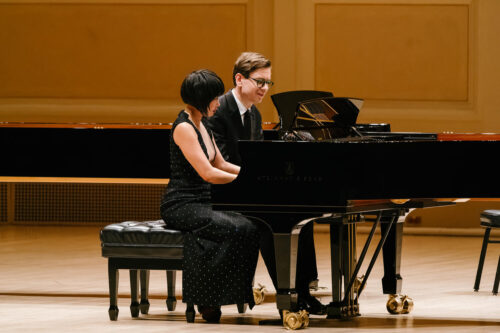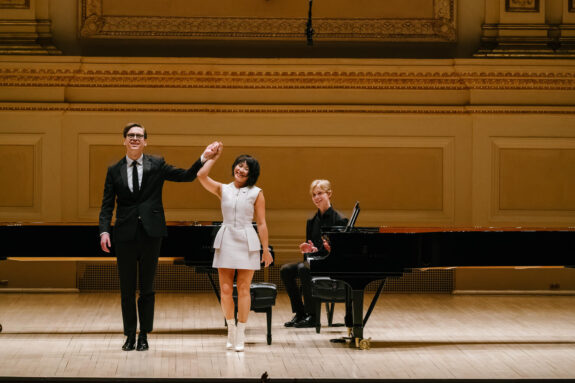 United States Various: Yuja Wang & Víkingur Ólafsson (pianos). Carnegie Hall, New York, 19.2.2025. (ES-S)
United States Various: Yuja Wang & Víkingur Ólafsson (pianos). Carnegie Hall, New York, 19.2.2025. (ES-S)

Berio – ‘Wasserklavier’ from Six Encores for Piano
Schubert – Fantasia in F minor, D.940
Cage – Experiences No.1
Nancarrow – Study No.6 (arr. Thomas Adès)
Adams – Hallelujah Junction
Pärt – Hymn to a Great City
Rachmaninov – Symphonic Dances
Encores:
Brahms – Waltz in E major, Op.39 No.2; Waltz in G-sharp minor, Op.39 No.3; Hungarian Dance No.1 in G minor
Dvořák – Slavonic Dance in E minor, Op.72 No.2
Schubert – Marche militaire in D major, D.733, No.1
Pairing two of today’s most celebrated pianists and exclusive Deutsche Grammophon artists, Yuja Wang and Víkingur Ólafsson, for a world tour was bound to generate excitement – but also posed potential challenges. The two exceptional musicians, at the height of their careers but no longer the latest sensations, have built their reputations on markedly different artistic personas and distinct approaches to repertoire. Both command an impressively wide range, yet Wang seems to have a predilection for the drama and virtuosity of Russian Romanticism, while Ólafsson is more drawn to the clarity and intricacy of Baroque and Classical works. However, their Carnegie Hall duo recital proved that differences can be complementary rather than oppositional, yielding music-making that thrived on spontaneity and an unwavering commitment to detail.
The recital’s program was carefully crafted, interweaving a pair of early and late Romantic masterpieces – Schubert’s Fantasia in F minor and Rachmaninov’s Symphonic Dances – with a series of contemporary works, some blending seamlessly into one another without cesurae. Berio’s brief ‘Wasserklavier’, with its barely audible, delicate whispers, served as a finely attuned prologue to the intimate and melancholic Schubert work. The bell-like sonorities of Pärt’s Hymn to a Great City found an immediate echo in the opening of Rachmaninov’s first dance.
Despite their diverse origins and inspirations, Berio’s ‘Wasserklavier’, Cage’s Experiences No.1 and Pärt’s Hymn to a Great City provided Yuja Wang and Víkingur Ólafsson with opportunities to delve into the nuances of balancing sound and silence. Each composition, marked by sparse textures, serene calm and a contemplative character, was rendered with refined sensitivity, allowing its introspective qualities to surface.
At the other end of the spectrum, Conlon Nancarrow’s Study No.6, arranged by Thomas Adès, is a work that, in less capable hands, might risk collapsing under its own rhythmic complexity. Originally composed for mechanical pianos, Nancarrow’s studies revel in the impossible – overlapping time signatures, interlocking patterns and vertiginous tempo shifts. Yet Wang and Ólafsson brought an almost effortless precision to the chaos, executing its layered textures with breathtaking clarity. They leaned into the jazz-inflected phrases with a buoyancy that belied the music’s difficulty, transforming its relentless rhythmic drive into something that felt spontaneous rather than mechanical. The sheer coordination required was staggering, yet their interplay had a playful ease, as if they were toying with the music rather than bound by its demands.
Schubert’s Fantasia in F minor, a piece conceived for the intimate resonance of a single instrument, can lose some of its whispered intensity when played on two pianos. Here, they were positioned one behind the other, facing in opposite directions, with Yuja Wang, the evening’s primo player, seated closer to the audience. Rather than creating distance between the interpreters, the physical space seemed only to heighten their expressive range. Eschewing unnecessary effusiveness, this rendition revealed a remarkable fusion between Wang’s mercurial phrasing and Ólafsson’s chiseled clarity. The lyrical second theme had a wistful grace, and the fugal section emerged with crystalline precision. Their coordinated rubato was generous yet never indulgent and, even in the stormier moments, there was a sense of restraint – a choice that made the final, hushed cadence all the more poignant.
A perfectly paced performance of John Adams’s Hallelujah Junction – a high-speed chase of relentless pulses and rhythmic crosscurrents demanding extreme precision and fearless abandon – was one of the evening’s high points. As two of Adams’s finest interpreters – Wang premiered Must the Devil Have All the Good Tunes, and Ólafsson his latest piano concerto, After the Fall – their command of his intricate rhythms and manic energy was truly remarkable. From the opening salvo, Ólafsson set the pace with near-mechanical crispness, while Wang’s electrifying exuberance threatened to push the piece into overdrive.
The second half featured the recital’s largest work: Rachmaninov’s Symphonic Dances which, even in its two-piano version, retains the sweeping grandeur of its orchestral counterpart while revealing remarkable transparency. Wang took command from the outset, her articulation slicing through the dense textures with steely yet poetic brilliance. Ólafsson, ever the craftsman, shaped the inner voices with meticulous detail, ensuring clarity never came at the expense of power, yet his playing felt slightly rigid at times compared to Wang’s sinuous phrasing. The Tempo di valse was particularly striking – its subtle chromaticism both playful and menacing, the waltz rhythm, like Ravel’s, swaying uneasily between elegance and collapse. By the finale, as the Dies irae theme clashed with quotes from Rachmaninov’s All-Night Vigil, Wang and Ólafsson embraced the full weight of the music’s existential struggle, driving it to its triumphant, almost defiant conclusion.
Ólafsson and Wang played five encores, this time on a single piano, none reflecting their special interest in twentieth- and twenty-first-century music. Yet the sense of witnessing a genuine dialogue inter pares – neither overly cautious nor merely a showcase for virtuosity – was as present in these little gems by Brahms, Dvořák and Schubert as it had been throughout the evening
The repertory for piano duos, including various adaptations, is less limited than often assumed. One can only hope that Wang and Ólafsson will continue exploring it together to our delight.
Edward Sava-Segal
Featured Image: Víkingur Ólafsson & Yuja Wang © Fadi Kheir

I just saw their wonderful concert at Cleveland’s Severance Hall…absolutely fantastic!
We saw it in Boston on the 21…. Loved reading this review and nodding with enthusiasm. How fortunate to experience this!